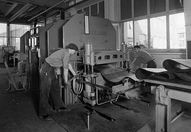Asia
EMEA
History
The fascinating history of synthetic rubber started with an idea patented 100 years ago.
In 1909, the chemist Fritz Hofmann succeeded in producing the elastic substance methyl-isoprene, thus paving the way for the development of synthetic rubber. Hofmann conducted his research at the laboratories of “Elberfelder Farbenfabriken vorm. Friedr. Bayer & Co.” – a company whose tradition is carried on today by the specialty chemicals group LANXESS.
Not a lot was known about rubber back then. For example, not until 1905 did chemists discover that the chain molecules of this elastic material are comprised of countless strings of isoprene molecules, which, at that time, no one knew how to crosslink. Hofmann decided to give it a try. Because of the difficulties of producing the “natural rubber module” isoprene, he quickly settled on using methyl-isoprene, which has a very similar chemical structure and was easier to manufacture. Hofmann placed the material in tins, heated them and waited – sometimes even for months. Depending on the temperatures involved, the substance that formed in the tins was sometimes softer and sometimes harder, but it was always elastic. As it turned out, Hofmann had invented methyl rubber. Thus, a hundred years ago, the patent for the world’s first synthetic rubber was awarded on September 12, 1909.
Continental – a leading rubber company even back then – started to produce the first car tires from this new material as early as 1910. Hofmann’s boss, Carl Duisberg, traveled 4,000 kilometers on the tires “without a puncture.” Even the German Kaiser soon had his car fitted with the tires and was “extremely pleased” with the results.
- Gallery






